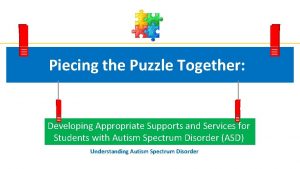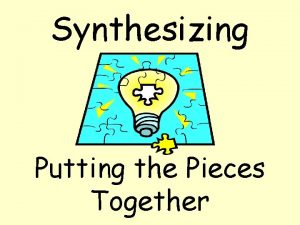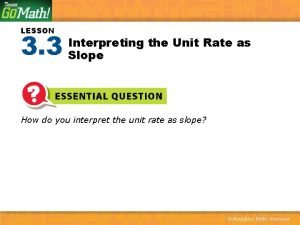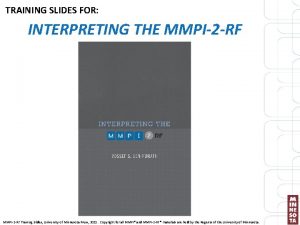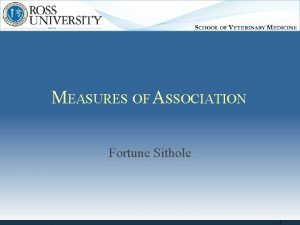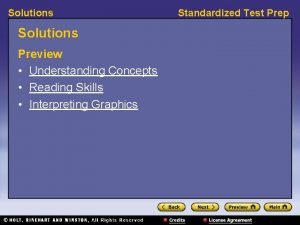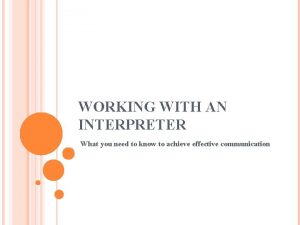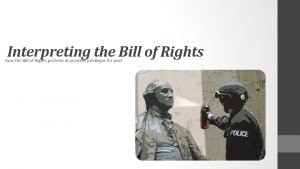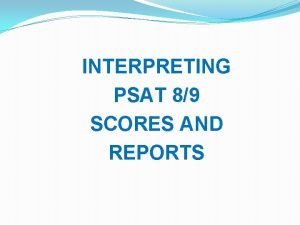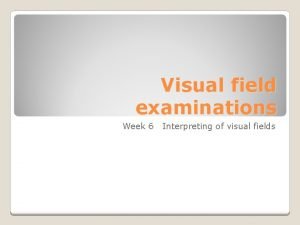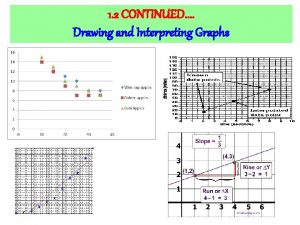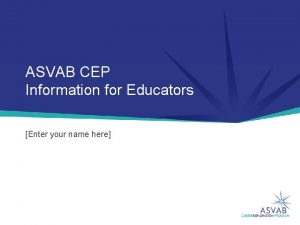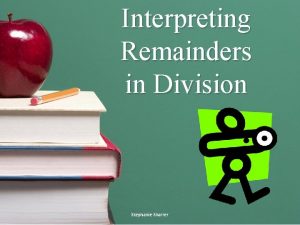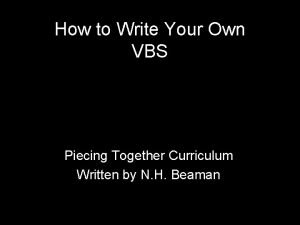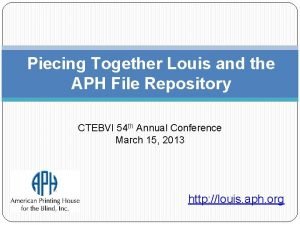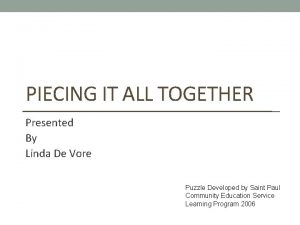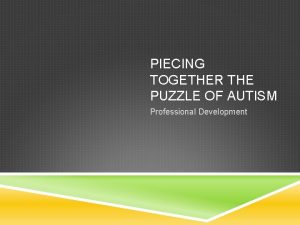Piecing Together Interpreting How to look at interpreting




























- Slides: 28

Piecing Together Interpreting How to look at interpreting work through the demand-control schema (DC-S)

Introduction to Demands & Controls Any job can be divided up into demands (what the job requires of the employee) and controls (what the worker brings to bear in response to job demands). Demands are about the job l Controls are about the worker l

This understanding of work components and definitions of demands and controls was originally defined by Robert Karasek (1979) for his research on occupational health

Definitions of Demands l Requirements of the job l Factors that impact worker l Work challenges faced by employee l Demands are not necessarily demanding, just factors that impact work

Dean & Pollard’s Demand Categories Ø Environmental That which is specific to the setting (i. e. , goal, professional roles, terminology, physical surroundings) Ø Interpersonal That which is specific to the interaction of the consumers and interpreter (i. e. , culture, FOI, goals) Ø Paralinguistic That which is specific to the expressive skills of the deaf/hearing consumers (i. e. , style, pace, volume) Ø Intrapersonal That which is specific to the interpreter (i. e. , thoughts, feelings, physical reactions)

Environmental Demands l l Goal or purpose of setting Terminology associated with this setting Personnel or clientele in this setting Physical surroundings of the setting l Room temperature l Chemicals and odors l Seating arrangements/sight lines l Lighting quality l Visual distractions l Background noise l Space (people, furniture, equipment)

Interpersonal Demands l Dynamics that exist between all parties including the interpreter, such as: l Power & authority dynamics l Communication style and goals l Emotional tone or mood l Role and cultural differences l Communication flow (e. g. , turn taking) l Relationship nuances (new, familiar, intimate) l “Thought worlds” of hearing & deaf people

Quote about Thought Worlds “Interpreting…is not merely transposing from one language to another. It is, rather, throwing a semantic bridge between two different cultures, two different thought worlds. ” --Claude Namy (1977)

Paralinguistic Demands: Idiosyncrasies of speaking l Volume l Pace l Accents l Clarity of speech l Physical position l Physical limitations l

Intrapersonal Demands l l l Feelings or ruminations one may have about: l one’s safety l one’s interpreting performance l liability l the people and the dynamics l the environment physiological distractions psychological responses or distractions

Definitions of Controls l l Decision latitude afforded to the worker Response to job demands l l l Better understood as noun and not verb (to control, to be in control, feel out of control are not accurate applications of control) Controls are about the employee Controls in interpreting must also include characteristics of interpreter (gender, age, ethnicity, etc. ) because interpreting is a practice profession & about human interaction

Dean & Pollard’s Control Categories Ø Pre-assignment controls: controls that exist or are employed before for the formal assignment. Ø Assignment controls: controls that are employed during the interpreting assignment. Ø Post-assignment controls: controls that are employed after the assignment is over.

Pre-assignment Controls l l l Physical, cognitive, and psychological attributes l Gender, age, ethnicity, etc. Interpreting education: Direct and Indirect Credentials: Certification or QA Experience: Work-related and personal Direct preparation for the assignment l Clothing l Contacts (team, hearing & deaf consumers) l Readings, prep materials, Internet

Assignment Controls Identifying demands l Positive Self-talk l Direct interventions l Interpretations/Translations l Prior Relationships l Code of Ethics/Code of Professional Conduct l Role metaphors (machine, window, telephone line, Bi-Bi, Ally) l

Post-assignment Controls l Supervision l l l Debriefing/venting l l With support system Follow up l l Formal (with supervisor) Informal (with colleagues) With people involved With further education With referring party Self-care

Theoretical Construct of DC-S Karasek’s concepts: Demands Dean & Pollard’s application Environmental Interpersonal Paralinguistic Intrapersonal Controls Pre, During, & Post

Example of DC-S Analysis

First Grade Classroom at Reading Time l The teacher in a first grade class has called her students over to the carpet for story time. The story is about penguins and their adventures as a performing group. The students are seated on the carpet and listening to the continuing story of the penguins. There is an interpreter seated next to the teacher and a deaf student seated on the carpet in the middle facing both teacher and interpreter.

Environmental Demands l Goal: Education l l Personnel/Clientele: l l Entertainment 20 first graders: Most Caucasian, some African-American Teacher: Hispanic female, mid-30’s Physical Surroundings: students seated on “reading carpet”, crowded, teacher in front on rocking chair, visually busy walls, door to the hallway is open, gerbil cage with running wheel Terminology: associated with penguins, performance, specific character names, vocabulary and grammar instruction

Interpersonal Demands l l l Teacher uses facial expressions and gestures for correcting children A student complains she can’t see the picture Teacher asks students to predict what might happen The story is visually interesting and students are fascinated watching the interpreter Student calls out “How do you sign penguin? ” Another student is sneaking candy from his pockets and distributing it to some; others ask but he refuses; teacher is not aware

Paralinguistic Demands “Read” material l Teacher has a Hispanic accent l She reads slowly and pauses for emphasis l Deaf kid signs with one hand (other hand is propping himself up) using his voice l Kid’s are whispering to each other about the candy l Intermittent noise from the hallway makes the story hard to hear l

Demands

Intrapersonal Demands In order to get a good idea of intrapersonal demands for this scenario, you will have to place yourself as an interpreter in this scenario. Imagine yourself in this job. What intrapersonal demands would you be facing? l Share your intrapersonal demands with your classmates; note the differences for a later discussion about the interaction of demands and controls! l

Pre-assignment Controls l l l Read the chapter ahead of time Find a comfortable place to sit Make sure I am placed close enough to the teacher and the book Mentally prepare myself for a lot of distracting sights and sounds Ask teacher if some signs from the story could be taught to the class (via deaf student and/or interpreter) so to avoid too many interruptions during story and to encourage interest in their classmate’s language

Assignment Controls l l Use good visual ASL (use of space and facial expressions) to show the comedic and active nature of the story Make teacher’s subtle correction of behavior more overt by “signing” the inferred meaning Make eye contact with the boy passing out candy and give the “I see you” facial expression Make eye contact with students who are watching the ASL with interest and smile with encouragement

Assignment Controls When the deaf student signs with one hand use consecutive interpreting to figure it out, if still unclear ask for clarification, highlighting the disclarity or ask student to use both hands l Pause with teacher to show similar emphasis techniques in ASL l Use sign vocabulary taught to class deliberately for those paying attention l

Post-Assignment Controls l l Briefly highlight any plot changes or developments in the story with deaf student to ensure clarity of translation Encourage students’ new vocabulary and encourage interaction with deaf student after story (redirecting attention back to their classmate) Thank teacher for taking time out at the beginning of the story to respond to students’ curiosity Consider whether the “candy” disruption should be reported to the teacher and ask for guidance on future behavior issues ( i. e. , how she would like me to deal with them -- ignore or report).

Piecing Together Any Assignment l Any interpreting assignment will have EIPI demands for interpreters. If you can piece together EIPI demands either before the assignment (and be ready for them by employing pre-assignment controls) or when you walk into any job, you will be able to respond to these demands more effectively which is good for you and your consumers.
 Piecing the puzzle together
Piecing the puzzle together Look up look down look all around
Look up look down look all around Vragen
Vragen Putting the puzzle together main idea
Putting the puzzle together main idea Look at the picture in activity 1
Look at the picture in activity 1 What's in activity 1 looking back
What's in activity 1 looking back Activity 1 look out
Activity 1 look out Gish model of interpreting
Gish model of interpreting 3-3 interpreting the unit rate as slope
3-3 interpreting the unit rate as slope Interpreting the mmpi-2-rf
Interpreting the mmpi-2-rf Interpreting relative risk
Interpreting relative risk Misleading graph
Misleading graph Interpreting graphics
Interpreting graphics Types of interpreting
Types of interpreting Phase diagram ap chemistry
Phase diagram ap chemistry Interpreting the bill of rights
Interpreting the bill of rights 2009 delmar cengage learning
2009 delmar cengage learning Brigance scoring
Brigance scoring Interpreting distance time graphs
Interpreting distance time graphs Interpreting line graphs year 5
Interpreting line graphs year 5 Interpreting psat scores
Interpreting psat scores River valley contour lines
River valley contour lines Interpreting circle graphs
Interpreting circle graphs Interpreting visual fields
Interpreting visual fields Drawing and interpreting graphs
Drawing and interpreting graphs Asvab access code
Asvab access code Interpreting the remainder
Interpreting the remainder Topographic map interpretation
Topographic map interpretation Analyzing and interpreting data in research
Analyzing and interpreting data in research
